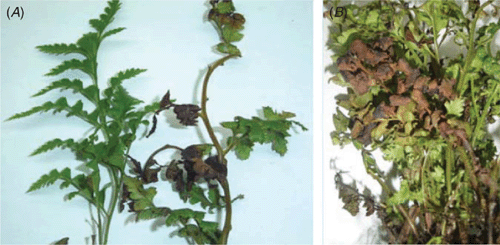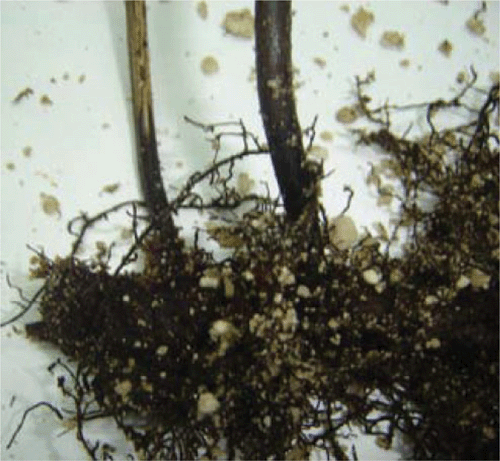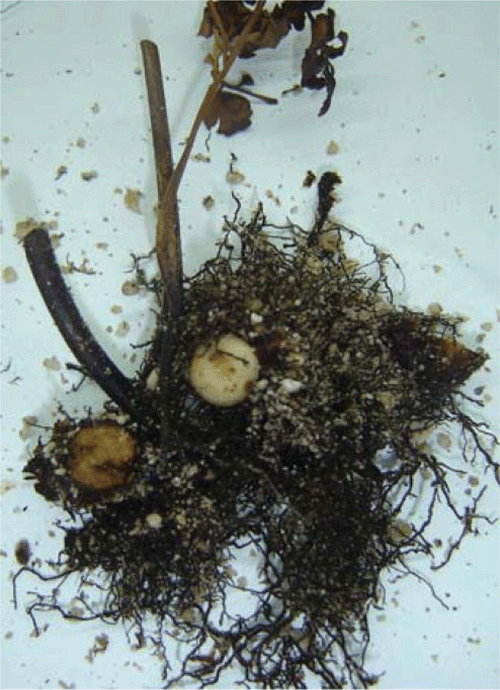Cylindrocarpon destructans, causing root and rhizome rot in Rumohra adiantiformis
H. E. P. Palmucci A B and P. E. Grijalba AA Facultad de Agronomía de la Universidad de Buenos Aires (FAUBA), Av. San Martín 4453 (1416), Buenos Aires, Argentina (UBACYT G005).
B Corresponding author. Email: palmucci@agro.uba.ar
Australasian Plant Disease Notes 4(1) 105-107 https://doi.org/10.1071/DN09044
Submitted: 23 August 2009 Accepted: 14 September 2009 Published: 7 October 2009
Abstract
This is the first report of Cylindrocarpon destructans causing leaf blight and root and rhizome rot of Rumohra adiantiformis. The fungus was consistently isolated from diseased tissue and identified as Cylindrocarpon destructans based on its morphological and cultural characteristics. The corresponding teleomorph (Nectria radicicola) was not detected. Inoculation tests were carried out which confirmed this fungus as the causal agent of the disease.
There is no report on the pathogenicity of Cylindrocarpon sp. on Rumohra adiantiformis in Argentina or in any other country. The objectives of our research were to report the presence of Cylindrocarpon destructans in greenhouse Rumohra plants, and to determine its pathogenicity.
The fungus Cylindrocarpon destructans is very widespread, particularly in forest soil, frequently occurring in soil or associated with the roots or underground parts of a large number of woody and herbaceous hosts. It has been frequently reported causing a disease on numerous forest, fruit and ornamental species (Booth 1966; Dahm and Strzelczyk 1987; Montecchio and Causin 1995; Besoain and Piontelli 1999). In Argentina the genus Cylindrocarpon sp. was reported on Lavandula dentata L. (Lavanda) and Lavandula × intermedia Emeric ex Lois. (lavandín) causing basal rot (Wolcan and Grego 2004); and on Vaccinium corymbosum L. (arándano) causing root rot (Hongn et al. 2007). Nectria radicicola, the teleomorph of Cylindrocarpon destructans, was mentioned in 1956 affecting Narcissus tazetta L. (Rossi 1956).
In the summer of 2007 and 2008 a survey was carried out on the diseases present in horticultural crops growing in soil-less systems located in the vicinity of Buenos Aires and La Plata, Argentina. Nurseries of Rumohra adiantiformis (G. Forst.) Ching, were affected by a new disease with low prevalence and high incidence that severely limited its production, with approximately a 40% loss.
Rumohra adiantiformis (G. Forst.) Ching is a worldwide evergreen fern which belongs to the Polypodiaceae family. The common name is leather-leaf fern or iron fern (Parodi and Dimitri 1978) and it is often used in cut-flower arrangements and for groundcover in shaded locations. Several symptoms were observed on young plants developed in beds and pots with peat growing medium. The plants initially showed a few elliptical brown spots on leaves, then blight (Fig. 1) and wilting due to root and rhizome rot, which in 10–15 days killed most of them (Fig. 2). Rhizomes showed a few dark vessels (Fig. 3). Such plants could be easily removed from the pots due to the destruction of the root system. Symptoms developed faster (7–10 days) in hot weather, damp soil and high relative humidity.

|

|

|
Small pieces (3–4 mm diameter) of leaf, rhizomes and root tissue, were surface disinfected by immersion in a solution of 2% sodium hypochlorite for 2 min and then rinsed several times in sterile distilled water, were then placed on 2% potato dextrose agar (PDA), acidified to pH 6.5, in Petri dishes which were incubated in the dark at 22 ± 2°C for 48 h. Later they were subjected to a 12-h photoperiod (near ultraviolet light, Philips tubes TL 40/08), at the same temperature (Badford 1992). The identification of the fungi was based on morphology of their reproductive structures and cultural characteristics (Booth 1966). The isolate is kept in the FAUBA fungal collection.
Pathogenicity tests were carried out on young potted plants. Stem bases and roots of five healthy Rumohra adiantiformis plants were inoculated with a spore suspension adjusted to 104 conidia/mL obtained from a 10-day-old culture grown on PDA. Inoculated plants were covered with plastic bags to maintain high relative humidity and were placed in a growth chamber at 22°C ± 2°C for 48 h, and later they were kept in the greenhouse for a period of 10 days. Disease symptoms were observed daily. When foliar symptoms appeared, segments of rotten root and rhizome were surface-disinfected, as described previously, and placed on PDA plates for re-isolation of the pathogen. Control plants were inoculated only with sterile, distilled water. The same fungus was consistently isolated from the diseased plant tissues. After 48 h of incubation, fungal growth was observed forming a white cottony mycelium, which later turned yellowish on the upper side and reddish-brown on the reverse of the Petri dishes. After 1 week (10–12 mm diameter of growth) a reddish-brown pigmentation was observed in the medium.
Microscopic observations revealed septate hyphae and oval to elliptical microconidia (8–10 × 3.5–4.0 µm) developed on short lateral branches, which formed one or more cylindrical phialides. Macroconidiophores developed on lateral branches, terminating in one or more phialides, which formed macroconidia (28–40 × 5.5–6.0 µm) which were hyaline, cylindrical, with rounded ends, straight or curved and narrowing slightly toward the base, 1–3 septate (3 in most of them). Chlamydospores (10–11 µm diam.) were also observed which were globose, smooth, hyaline, turning brown. They were intercalary or terminal in the mycelium and single or in chains. Based on these cultural, morphological and micrometric characteristics, the fungus was identified as Cylindrocarpon destructans (Zinssmeiter) Scholten. The corresponding teleomorph Nectria radicicola (Gerlach & Nilsson) was not observed.
After 7 days the inoculated plants showed similar symptoms as the spontaneously diseased plants. Initially there was chlorosis of basal leaves. In the second week leaf blight progressed from the tip to all the leaf, petiole and crown. Control plants remained symptomless. Koch’s Postulates were fulfilled by re-isolating the same fungus from the inoculated plants. It was concluded that Cylindrocarpon destructans is the causal agent of root and crown rot of Rumohra adiantiformis. This is the first report of Cylindrocarpon destructans in Argentina and the first report of this fungus causing disease on Rumohra adiantiformis.
Besoain CX, Piontelli LE
(1999) Root rot caused by Cylindrocarpon. Pudrición negra en raicillas de palto (Persea americana Mill.) por Cylindrocarpon destructans: patogenicidad y aspectos epidemiológicos. Boletín Micológico 14, 41–47.

Booth C
(1966) The genus Cylindrocarpon. Mycological Papers 104, 1–54.

Dahm H, Strzelczyk E
(1987) Cellulolytic and pectolitic activity of Cylindrocarpon destructans (Zins) Scolt. Isolates pathogenic and non-pathogenic to fir (Abies Alba Mill.) and Pine (Pinus sylvestris L.). Journal of Phytopathology 118, 76–83.
| Crossref | GoogleScholarGoogle Scholar |
CAS |

Montecchio L, Causin R
(1995) First Report of Cylindrocarpon destructans on English Walmut in Italy. Plant Disease 79, 967.
| Crossref | GoogleScholarGoogle Scholar |



